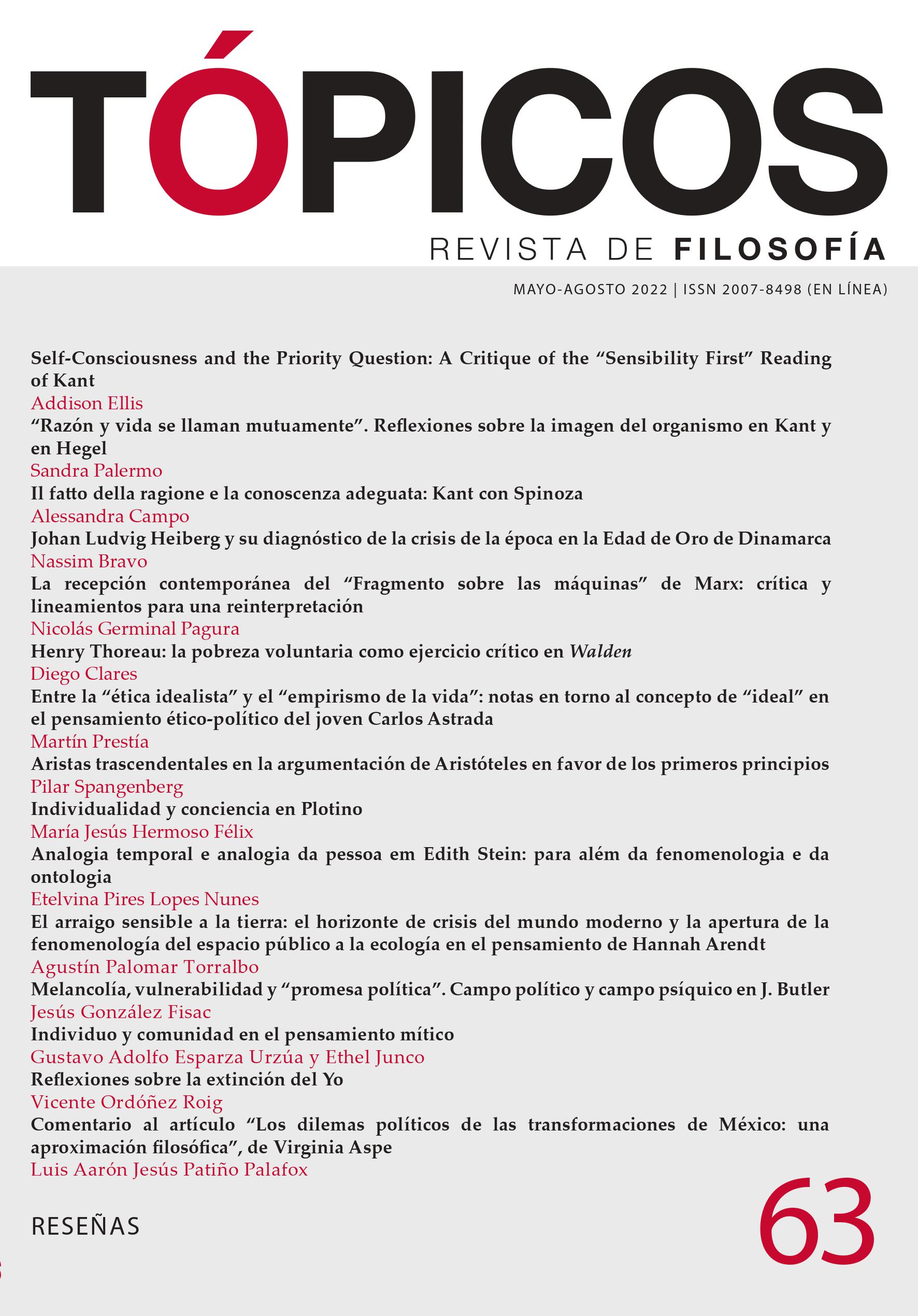Publicado 2022-04-18
Palabras clave
- Yo,
- fenomenología,
- vacío,
- budismo,
- no Yo
Derechos de autor 2022 Tópicos, Revista de Filosofía

Esta obra está bajo una licencia internacional Creative Commons Atribución-NoComercial-SinDerivadas 4.0.
Cómo citar
Resumen
El pensamiento occidental supone que hay un Yo singular, unitario y sólido, valor supremo y cimiento o base de la libertad, el autoconocimiento y la autenticidad. Ahora bien, ¿hay realmente un Yo autoidéntico y unitario? ¿Es responsable el Yo del control de lo que ocurre en su interior? ¿O algo se le escapa? ¿Puede la autoexploración revelar elementos desconcertantes de su configuración interna? ¿Es posible anular y, en última instancia, extinguir el Yo? El objetivo de este artículo es proporcionar posibles respuestas a estas y otras cuestiones derivadas del análisis de algunas de las aportaciones más significativas de la filosofía occidental y la budista al estudio del Yo.
Referencias
- Arnau, J. (2005). La palabra frente al vacío. Filosofía de Nāgārjuna. FCE-El Colegio de México.
- Bodhi, B. (1999). A Comprehensive Manual of Abhidhamma. The Abhidhammattha Sangaha of Ācariya Anuruddha. BPS.
- Bodhi, B. (2000). The Connected Discourses of the Buddha. A New Translation of the Saṁyutta Nikāya. Wisdom Publications.
- Bonardel, F. (2005). Bouddhisme et philosophie : la question de l’identité. Les cahiers bouddhiques, 1, 102-123.
- Cornu, P. (2001). Dictionnaire encyclopédique du bouddhisme. Éditions du Seuil.
- Childers, R. C. (1993). A Dictionary of the Pali language. Asian Educational Services.
- De Hipona, A. (1841). De vera religione. En Opera omnia. (cols. 121-172). (PL 34). J. P. Migne (ed.). Garnier.
- De Jong, J. (1950). Le problème de l’absolu dans l’école Mâdhyamaka. Revue Philosophique de la France et de l’Étranger, 140, 322-327.
- De Lubac, H. (2000). La rencontre du bouddhisme et de l’Occident. En OEuvres complètes. XXII. (pp. 1-350). Cerf.
- Descartes, R. (1973). Meditationes de prima philosophia. En OEuvres. VII. (pp. 1-90). C. Adam y P. Tannery (eds.). Vrin.
- Dragonetti, C. (1995). Dhammapada. La esencia de la sabiduría budista. Editorial Sudamericana.
- Faure, B. (1986). Le traité de Bodhidharma. Éditions le Mail.
- Fichte, J. G. (1969). Grundlage der gesamten Wissenschaftslehre als Handschrift für seine Zuhörer. En Werke. 1793-1795. Band I, 2. (pp. 173-463). H. Jacob y R. Lauth (eds.). Frommann Verlag.
- Figueroa, Ó. (2017). La Bhagavad-Gītā. El clásico de la literatura sánscrita y su recepción. UNAM-Juan Pablos Editor.
- Freud, S. (2001). El yo y el ello. En Obras completas. Tomo VII. (pp. 2701-2728). Biblioteca Nueva.
- Ganeri, J. (2017). Philosophy in Classical India: The Proper Work of Reason. Routledge.
- Harvey, P. (2004). The Selfless Mind. Personality, Consciousness, and Nirvana in Early Buddhism. Routledge.
- Hume, D. (2011). A Treatise of Human Nature. Volume I. D. F. Norton y M. J. Norton (eds.). Oxford University Press.
- Husserl, E. (1950). Ideen zu einer reinen Phänomenologie und phänomenologischen Philosophie I: Allgemeine Einführung in die reine Phänomenologie. Martinus Nijhoff.
- Husserl, E. (2006). Investigaciones lógicas. I. Alianza.
- Jung, C. (1993). Las relaciones entre el yo y el inconsciente. Paidós.
- Kalupahana, D. J. (1999). Mūlamadhyamakakārikā of Nāgārjuna. The Philosophy of the Middle Way. Motilal Banarsidass Publishers.
- Lamothe, M.-J. (1995). La Vie. Éditions du Seuil.
- Lemort, A. (2012). La double méprise. De l’illusion de la réalité du moi. Les Deux Océans.
- Luna Bravo, J. L. (2019). El cuidado de la obra de arte y la Phantasía: una lectura complementaria entre Husserl y Heidegger. Tópicos.
- Revista de Filosofía, 56, 145-165. DOI: http://dx.doi.org/10.21555/top.v0i56.940.
- Maillard, C. (2014). India. Obra reunida. Pre-Textos.
- Maillard, C. (2019). La compasión difícil. Galaxia Gutenberg.
- Merleau-Ponty, M. (1989). Phénoménologie de la perception. Gallimard.
- Nāgārjuna. (2011). Fundamentos de la vía media. J. Arnau (ed. y trad.). Siruela.
- Pániker, S. (2008). Asimetrías. Apuntes para sobrevivir en la era de la incertidumbre. Debate.
- Parakranabahu, A. (2014). El Sutra de Benarés. Primer discurso del Buddha. [Dhammacakkappavattana Sutta]. Kairós.
- Platón. (1998). Diálogos. Tomo IV. República. C. Eggers Lan (trad.). Gredos.
- Rhys Davids, T. W. y Rhys Davids, C. A. F. (1971). Dialogues of the Buddha. II. The Pali Text Society.
- Rhys Davids, C. A. F. (1995). The Book of Kindred Sayings. (Saṁyutta Nikāya). Part III. The Book on Elements (Khandhā-Vagga). The Pali Text Society.
- Tola, F. y Dragonetti, C. (2008). Filosofía de la India. Del Veda al Vedānta. El sistema Samkhya. El mito de la oposición entre “pensamiento” indio y “filosofía” occidental. Kairós.
- Tolstói, L. (2019). El camino de la vida. S. Ancira (trad.). Acantilado.
- Varela, F. J. (2006). Dormir, soñar y morir. Una exploración de la consciencia con el Dalai Lama. Gaia Ediciones.
- Varela, F. J., Thompson, E. y Rosch, E. (2011). De cuerpo presente. Las ciencias cognitivas y la experiencia humana. Gedisa.
- Wijayaratna, M. (1995). La philosophie de Bouddha. Éditions Lis.
- Wijayaratna, M. (2006). Sermons du Bouddha. Éditions du Seuil.





